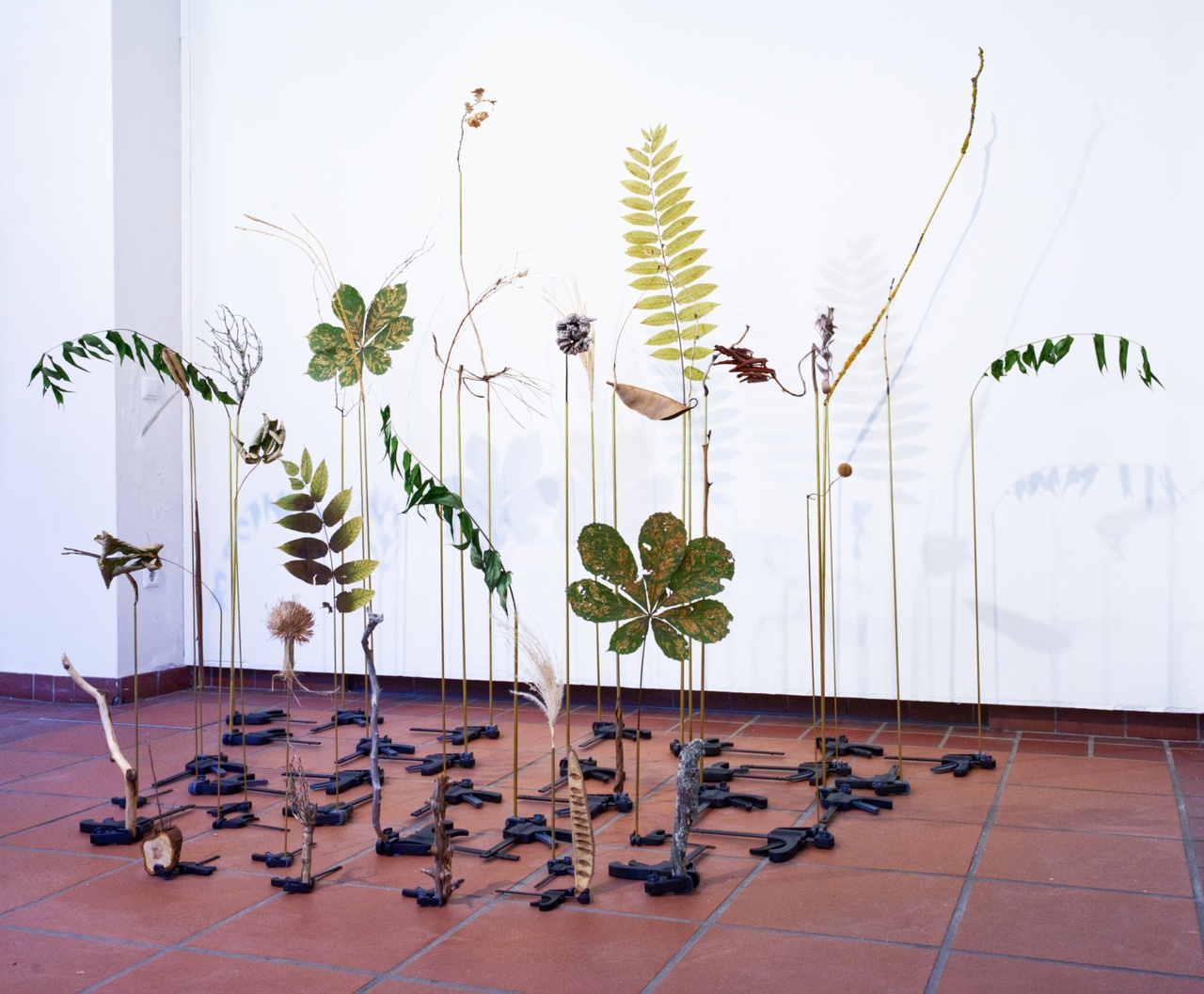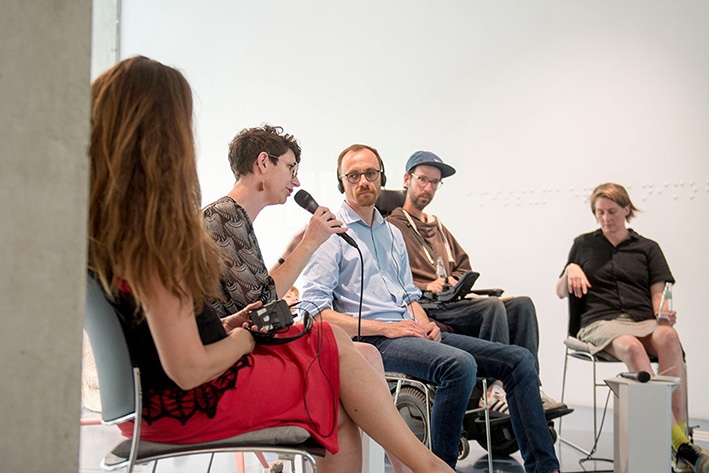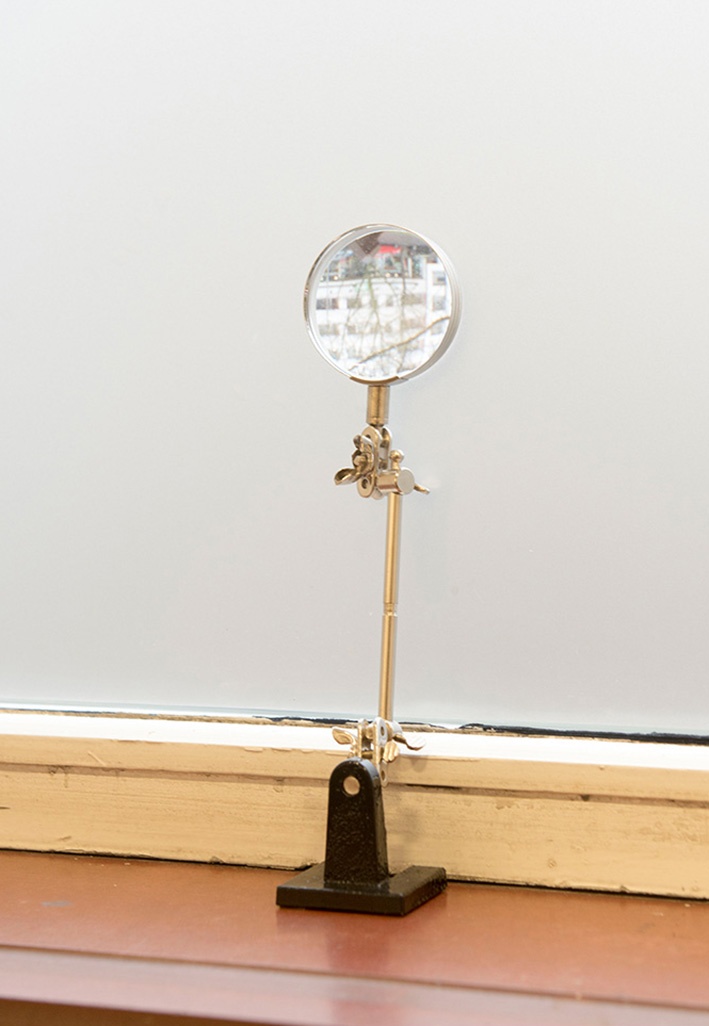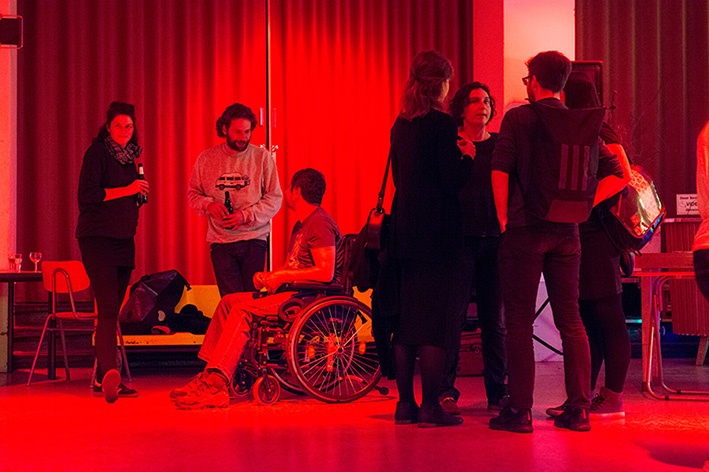THE FUTURE OF SOCIAL COHESION? Kate Brehme on Berlin’s Austerity Politics in the Cultural Sector

Andrea Acosta, “Jardín Asistido,” 2019, “Unruly Splendour”, in Galerie im Körnerpark, Berlin, 2024
When I first arrived in Berlin over 12 years ago, disabled [1] artists were barely visible in galleries and on stages throughout the city, and funding criteria was highly exclusionary. Leading arts institutions were run by mostly white, cis, non-disabled people, and it was commonplace for so-called inclusive art projects to not actually feature any disabled or other marginalized people in decision-making positions. A lot has changed since. In 2015, my colleagues Jovana Komnenić, Dirk Sorge, and Kirstin Broussard conceptualized and were involved as expert speakers in “Inklusion ist Schön” at Hamburger Bahnhof, a two-day professional development workshop that demonstrated the yawning gap of knowledge and resources needed to address the systemic exclusion of disabled people within the Berlin arts scene. In 2017, Komnenić, Sorge, Broussard, and I founded Berlinklusion, a network for accessibility in arts and culture. Pooling together our knowledge and international contacts, Berlinklusion set out with the goal of creating a more accessible arts sector for disabled audiences and artists alike. Later that same year, we staged our inaugural event, “Meeting Place,” a symposium and mini arts festival we co-organized with Arts Access Australia and Diversity Arts Culture, held at Podewil. Over 250 arts workers from the independent scene and from arts institutions, along with local policy-makers, responded to our invitation and to make a commitment to better access and equity in the arts.
Berlinklusion comprises a mix of disabled and non-disabled artists and arts mediators. We each have around 15 years of experience working with artists or audiences with disabilities as well as within arts institutions in Germany and abroad, and we have built up a network with more than 200 contacts in the field of disability arts, including people with disabilities and people without disabilities who work inclusively (otherwise known as non-disabled allies). Over the past eight years, we have been providing advice to a variety of arts organizations throughout the city and curating our own art projects, mostly in the field of visual arts. While Berlinklusion’s area of expertise lies in improving access to the arts for artists and audiences with disabilities, our approach has always been intersectional, meaning that we recognize that different forms of inequality often operate together and exacerbate each other, and that the access you provide one group often benefits many others. Since Berlinklusion’s foundation, we’ve advised and carried out access evaluations for institutions such as HKW, Berliner Festspiele, Gropius Bau, Documenta, LAS Art Foundation, KW, and the Berlin Biennale; collaborated with Diversity Arts Culture in delivering a variety of community workshops and events; advised on the development of funding programs such as Durchstarten, IMPACT, and Berliner Projektfonds Urbane Praxis; and have curated our own disability-led arts projects, for example, UNBOUND, a transdisciplinary and accessible residency program for artists with and without disabilities (2022–23), “To/From” at Kommunale Galerie Berlin in Charlottenburg (2023–24), and “Unruly Splendour” at Galerie im Körnerpark (2024). For all the work that we do, the concept of access lies at the core. For us, access is not synonymous with inclusion; rather, access provides the necessary conditions for inclusion to work. Many of us in the disability community still feel there is a lot more that could be done. However, it is because of the work of grassroots activists together with a commitment to inclusion and diversity from the former Berlin government, in the form of financial investment, that we have seen a reduction of the barriers in the arts caused by racism, classism, sexism, ageism, and ableism.

“Access as Engine,” CLB, Berlin, 2023
For example, the establishment of Diversity Arts Culture in 2017, and its umbrella organization, the Stiftung für Kulturelle Weiterbildung und Kulturberatung (SKWKB), has been crucial to providing initial orientation for arts institutions as well as empowerment for marginalized arts workers. [2] Funding programs such as Durchstarten and IMPACT were initiated to specifically target those who face multiple barriers when entering into professional cultural work. IMPACT in particular enables the development of professional arts projects led by marginalized people, thus bridging gaps in the provision of education, qualification attainment, and work experience. In turn, the funded projects provide a unique opportunity for mainstream arts organizations to partner with marginalized communities and thus better reflect the diverse society we live in. Other funds administered by SKWKB, such as the Berliner Projectfonds Urbane Praxis, set a best practice model for providing low-barrier access to arts funding, and by prioritizing projects led by marginalized people. [3] Complimenting these activities, there has been an increase in the number of disabled people, queer people, and people of color sitting on all kinds of Berliner arts fund juries, which brings a much-needed diversity of perspectives to jury assessment processes. In December 2024, in a document leaked to the press, it was revealed that a swathe of planned funding cuts to the Berlin cultural sector would not only devastate the cultural sector in general but also disproportionately affect diversity and inclusion measures, such as the above mentioned initiatives and funds. [4] The news was shocking for two reasons: that no one within the cultural sector had been consulted either on how these proposed cuts should be carried out or on what their effect might be; and that it seemed as though, in one fell swoop, so much hard-fought change was about to be undone.
The reduction of barriers and efforts to include disabled people in the arts came about not just because of the will of the former cultural senator Klaus Lederer, but also because of demands from the arts sector itself. A number of mainstream arts institutions have used their funding to seek consultation, conduct evaluations, and carry out staff training with Berlinklusion or our colleagues at Platz-Da, [5] as well as committing to showing disabled and other marginalized artists in their programs (for example, “Aus der Krankheit eine Waffe Machen” at Kunstraum Kreuzberg, the No Limits festival at HAU, Sophiensaele, and Ballhaus Ost, and “Unruly Splendour” at Galerie im Körnerpark, all in 2024).
Such changes within the Berlin cultural scene are a response (albeit a somewhat slow one) to international and national legal obligations such as the UN Convention on the Rights of People with Disabilities and the German Behindertengleichstellungsgesetz (Disability Equality Act). These legal frameworks state that access to the arts, for people with disabilities, whether as an arts professional or a member of the public, is a human right and a legal right. More generally, the German Constitution (Grundgesetz Art. 3, Abs. 3) also states the legal right for all people, regardless of race, ethnicity, religion, sexual orientation, gender, or disability not to be excluded from society. With the current cuts in Berlin’s culture budget, all of the initiatives, changes, and support structures that strive not only for diversity and inclusivity but also help publicly funded arts organizations or projects to fulfill these legal obligations will be devastated. The impact on the diversity and inclusivity of the Berlin arts sector will be felt across many areas, including how much access arts spaces will be able to provide for diverse audiences, whether marginalized artists will be able to continue to contribute to the sector, and whether these artists will be able to continue to live and work in the city.

Jovana Komnenić and Dirk Sorge, “Die Auflösung des Sehens / The Resolution of Sight”, 2014/2023, “To/From exhibition in Kommunale Galerie, 2023–24
At the time of writing, funding for SKWKB has been completely cut and the Stiftung will be dissolved into the Senatsverwaltung. Diversity Arts Culture’s budget has been cut by 20 percent, and IMPACT’s funding reduced by 100,000 euros. Berlin Mondiale [6] has been completely cut, as has the Berliner Projektfonds Urbane Praxis, just two examples of the many other explicitly targeted initiatives that carry out inclusive or anti-discriminatory work in the arts. Arts institutions working most directly with communities, such as the Kommunale Galerien, will face budget cuts of up to 65 percent, including the scrapping of FABiK, which pays exhibition fees to exhibiting visual artists. These fees were barely enough to begin with for most Berlin-based artists; for many disabled artists who have additional access costs to produce their work (e.g., paying assistants, higher transport costs, or sign-language fees), the absence of these fees will mean that many will no longer be in a position to exhibit their work at all, let alone produce new work. Furthermore, unlike in other countries such as the United Kingdom, where arts institutions receive ring-fenced, or protected, funds for access measures, many arts institutions in Berlin often have to pay for access costs such as ramps, tactile floor systems, Braille, and audio guides, or access costs for artists, such as German Sign Language translation, from their own resources. With many having to make difficult choices between retaining staff or reducing programming, there is a fear that continuing or starting new access measures will fall off the agenda completely.
The cuts to funding for artist studios will also have an impact on diversity and inclusion in the arts. The artist studio funding program will be cut by 50 percent, and one of the main bodies for administering rental contracts for over 3,000 artists across the city, Kulturraum Berlin, will be abolished. The lack of availability of affordable artist studios and housing in Berlin is already a long-standing issue, as is the lack of availability of accessible or barrier-free studios. Many artists are forced to travel to the outer edges of the city in order to access affordable studios, often far from where they actually live, thus placing artists with limited mobility (whether due to disability or care obligations such as for children) at an immediate disadvantage. And with no clear political strategy for how to manage the complex relationship between the cultural sector and the city’s ever-changing urban landscape, the situation looks particularly dire for those already affected by multiple barriers.
The lack of transparency and productive communication between the current senator for culture and social cohesion Joe Chialo, the Senatsverwaltung, and the cultural sector about the recent cuts, and now about further cuts planned in the 2026/2027 budget, has led to much uncertainty and a stagnation in the field. For myself, and for Berlinklusion, the impact of these cuts is manifold. Short-term, we have already started to experience a slowing down of incoming work as arts institutions across the city assess their own financial situations. Projects have been postponed until there is more clarity. Some of our engagements, such as work on funding juries, have been completely cancelled. Long-term, it quite simply means that there will be fewer opportunities to provide access advice to arts organizations throughout the city, fewer opportunities for us to work curatorially, and less funding to pay for our access needs, for those of the artists that we work with, and for the public we serve. Being a cultural worker with a disability in Berlin was already precarious; with so much uncertainty about the future of the arts sector in general, our very existence as a sustainable disability-led arts organization is threatened.

“Berlinklusion Launch,” Aquarium, Berlin, 2017
And while we’re on the topic of sustainability, we fear that these cuts will stop the momentum that has been growing within the Berlin arts sector over the past decade, of hard-fought-for changes necessary to dismantling ableist and other discriminatory practices in the arts. We fear that these cuts will destroy an infrastructure that has been built up over many years that provides better access to the arts for diverse audiences and makes marginalized artists more visible. Just when we were starting to feel, finally, an acceptance amongst arts institutions, both independent and established, and an understanding that inclusion is not just a one-off box-ticking exercise but an ongoing task that is everyone’s responsibility, and something that can actually be the source of immense creativity, the resources necessary to do this important work have been revoked. With such recent positive developments being reversed, access to exhibition and art-making will need to be fought for, yet again, instead of empowering disabled and other marginalized arts workers like myself to “simply” make creative work.
It’s very clear what kind of practical implications these cuts will have on those in our city who already face so many barriers to the arts, and to their allies who wish to support them. But what I, along with my colleagues and community members find the most disturbing, is the government’s complete and utter disregard in fulfilling its legal obligations to providing access to the arts. That a party supposedly standing for Christian, democratic values and “social cohesion” could simply erase the existence of disabled and other marginalized people from the Berlin arts sector is, quite simply, discriminatory.
We are all affected by these budget cuts to the arts. We all know parents or children. We all know someone from the queer community. We all know people of color. We will all become disabled at some point in our lives. What happens when this diversity is no longer reflected in our galleries and on our stages, behind the velvet curtain and in the arts office? What happens when we can no longer get into the museum, when we can no longer afford theater tickets, or when we are discriminated against at work? If not reversed, these budget cuts will not only threaten opportunities for disabled and marginalized people to participate in the Berlin arts sector, it will also threaten the very identity of the city as one where it’s an asset, not a deficit, to be different.
Kate Brehme is a disabled curator and parent working and living in Berlin and is the cofounder of Berlinklusion Network for Accessibility in Arts and Culture. Her recently curated exhibitions include “Queering the Crip, Cripping the Queer,” an exhibition on Queer/Disability History, Activism, and Culture (Schwules Museum, 2022–23), “The Space Between” (CLB Berlin, 2023), which was the culminating exhibition of the UNBOUND residency program for artists with and without disabilities, and “Unruly Splendour: Exploring Nature Through the Spectrum of Bodies” (Galerie im Körnerpark, 2024).
Image credit: Photos 1. cvk*; 2.– 4. Jürgen Scheer
Notes
| [1] | I use a broad concept of disability and follow the social model of disability. This means that instead of defining a person by their health condition or impairment, disability is considered to be a social construction as people are dis-abled by barriers. This definition recognizes and respects that disability is defined by each individual and by their lived experiences, and it serves as an umbrella term for those who identify as sensorially, physically, or cognitively disabled or impaired, d/Deaf, chronically ill or sick, with learning difficulties, with mental illness, neurodiverse, and so on. |
| [2] | Since 2020, Stiftung für Kulturelle Weiterbildung und Kulturberatung (Foundation for Cultural Education and Cultural Consulting, SKWKB) has been the umbrella organization for four initiatives (Diversity Arts Culture, IKTf [Institute for Research on Cultural Participation], kultur_formen, and servicezentrum musikschulen) that advocate for more equal opportunities in Berlin’s cultural landscape and actively shape social and cultural policy discourse on this topic. The goal of their activities is to develop the cultural sector to reflect the existing diversity of our democratic society, in terms of its programs, personnel, audiences and accessibility. The Berlin state-based foundation is supported by the Berlin Senate Department for Culture and Social Cohesion. |
| [3] | Established in 2021, the aim of the Berliner Projektfonds Urbane Praxis is to promote a more solidary urban society with the help of art and culture and to consolidate new as well as existing partnerships. The goal of the project is to create more access to art and to break down barriers. The fund offers the opportunity to creatively shape the city independent of profit motivations. The fund was geared to all artists and cultural workers in Berlin and is especially focused on initiatives, communities, and individuals who have traditionally been excluded from funding due to (intersectional) discrimination. |
| [4] | Together with Anna Mülter, I wrote an open letter protesting the proposed cuts, which also affects artists who are BIPOC, queer, trans, or affected by other forms of discrimination. The letter received over 1,000 signatures in under 48 hours and was brought to parliament, where some of the proposed cuts were repealed. See here. |
| [5] | Platz-Da! is a Berlin-based consultancy organization that helps arts organizations reach new audiences and train employees through barrier-free cultural mediation formats. See platzda.berlin. |
| [6] | Berlin Mondiale initiates, accompanies, and qualifies intergenerational and interdisciplinary artistic collaborations in the context of migration, asylum, and exile. People interested in art or artists in exile who are structurally and institutionally denied access to resources cooperate with committed participants from various Berlin institutions. In recent years, Berlin Mondiale has directed its effort toward social spaces and cultural programs in non-central locations across Berlin. The network reached 13,000 young people from these neighborhoods and also residents of refugee shelters. |

